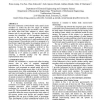Free Online Productivity Tools
i2Speak
i2Symbol
i2OCR
iTex2Img
iWeb2Print
iWeb2Shot
i2Type
iPdf2Split
iPdf2Merge
i2Bopomofo
i2Arabic
i2Style
i2Image
i2PDF
iLatex2Rtf
Sci2ools
FPL
2008
Springer
2008
Springer
Towards an "early neural circuit simulator": A FPGA implementation of processing in the rat whisker system
We have constructed a FPGA-based "early neural circuit simulator" to model the first two stages of stimulus encoding and processing in the rat whisker system. Rats use tactile input from their whiskers to extract object features such as size and shape. We use the simulator to examine the plausibility of the hypothesis that neural circuits in the rat's brain compute gradients of radial distance across the whisker array to make predictions about the environment. This prediction could be a component of a feed-forward signal that guides the navigation behavior of the rat. The use of a FPGA is highly suitable for such an application, because the computation involved in this system is a massively parallel problem. For our applications, we determined that a Cyclone II FPGA could simulate up to 14 neurons in parallel in just 265 ns achieving a 386-fold speedup over the software implementation of the same model.
FPL 2008 | Hardware | Neural Circuits | Rat Whisker System | Whisker |
| Added | 26 Oct 2010 |
| Updated | 26 Oct 2010 |
| Type | Conference |
| Year | 2008 |
| Where | FPL |
| Authors | Brian Leung, Yan Pan, Chris Schroeder, Seda Ogrenci Memik, Gokhan Memik, Mitra J. Z. Hartmann |
Comments (0)

